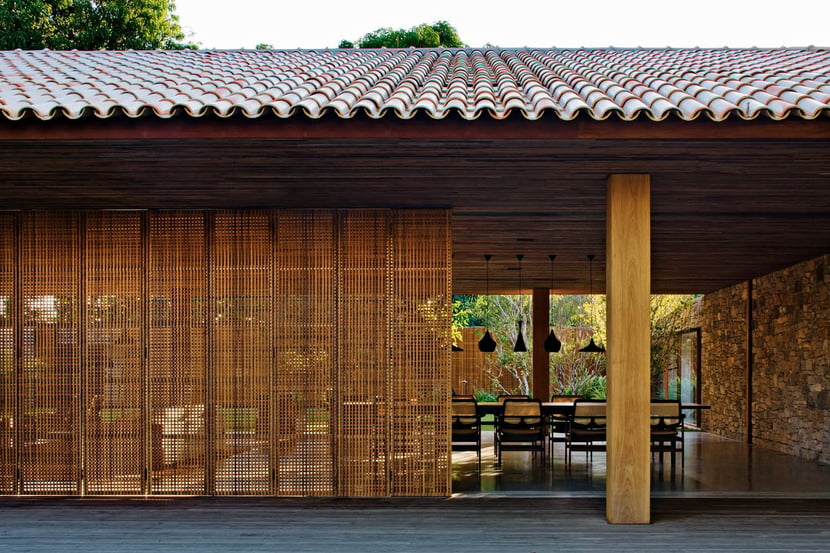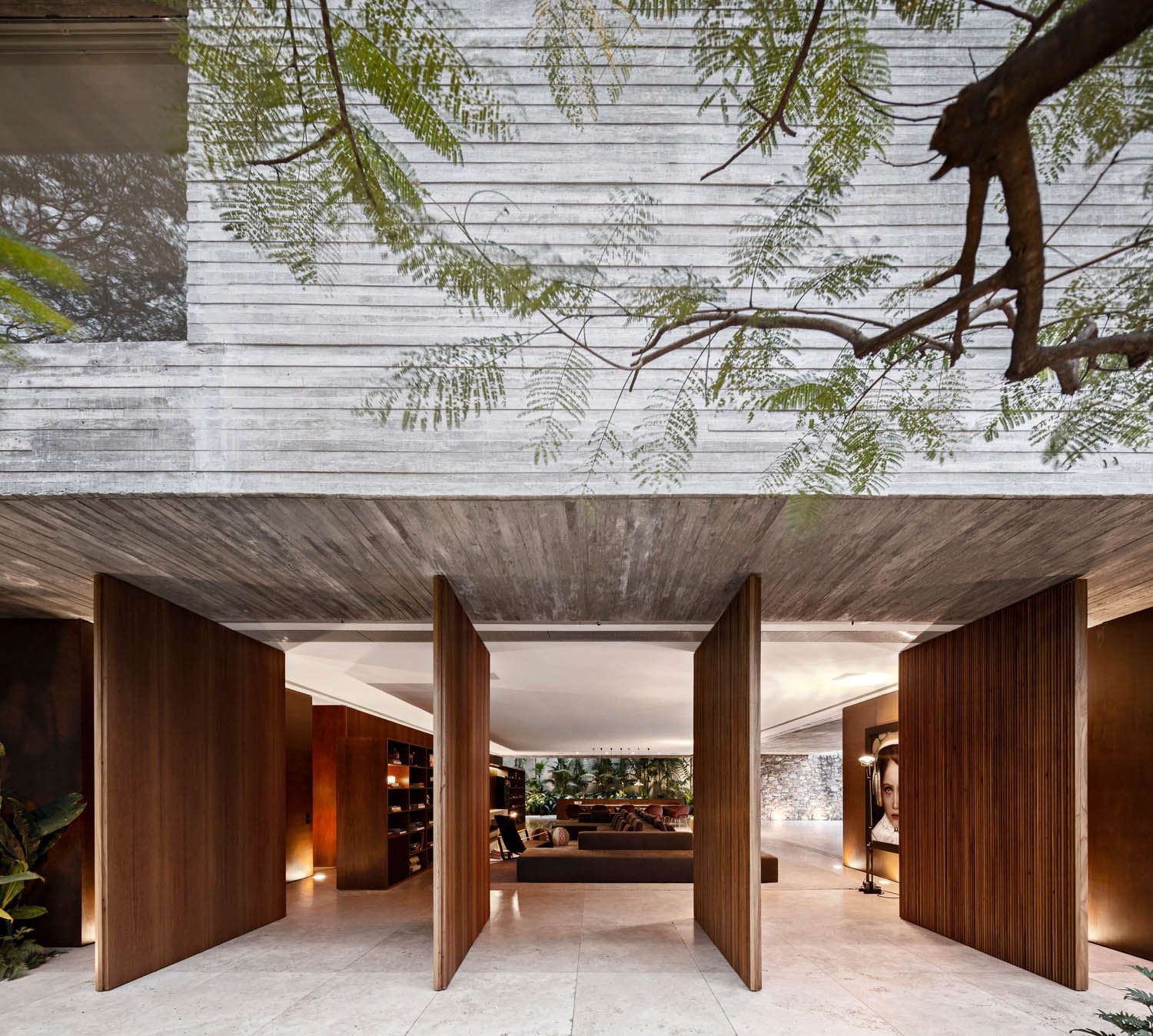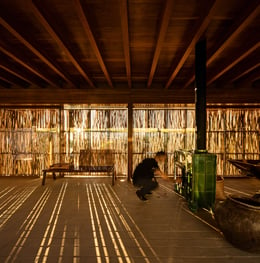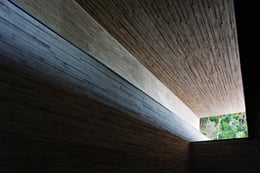Login
Registered users

Studio MK27’S works explore the full potential of our perceptions of space in a tactile dimension. Concealed within the roughness of stone or the precision of metal is a symbolic force that can trigger our most primitive sense-memories. Every material has a temperature, one that makes a potential contribution to what we experience and glean from a particular space. Indeed, one of the practice’s most important themes is the combination of materials, working on nuances from sharp to cozy.
The parallel formulation of internal and external spaces is always the starting point for each creative process, their boundaries diluted through the choice of materials. A stone façade shatters glass and breaks through internal space; white spreads ostensibly throughout every surface.
Our perception of full and empty spaces is partially expressed through materials: white is empty, programmatic boxes or a portico are wooden…
Material compositions make it possible to walk this fine line of tension between opposites. Studio MK27’s architects strive to strike a balance between simple volumetry and cozy spaces, creating a narrative that traverses narrow corridors to reveal broad landscapes: in a word, chiaroscuro. Ultimately, architecture must serve as a deliberate expression of our existential dualism. Progressing through the four elements of matter, the seven materials outlined below make up our architectural stylistic language.

As a coating, glass is so fine and liquid that it connotes transparency, reflection and diffusion. As a divider, it offers shelter yet at the same time allows us, from within an enclosed space, to see beyond.
Striking features of modern architecture, large reflective glass panels form crystal boxes through which we see the optically-distorted outside world. These panels also provide a surface on which the reflected backdrop blends with the private lives that unfold within the building.
Most importantly, glass lets natural light do its job. Nowadays, it is also able to absorb light and transform it into energy via photovoltaic cells. Ever since its chance discovery, thought to have been made by Phoenician merchants around 5000 B.C, glass itself has embodied the history of technological development, all the way through to the future of all communicative innovation, i.e. our device screens.
The passage of light makes us sensitive to the passing of time through space, unleashing infinite possibilities for designing and filtering light. We use glass bricks to create diffused lighting that will not expose the lives lived behind them. We also use polymers that reveal only the silhouettes of passers-by. We use large eaves to control how much light enters through glass structures and windows, and we often extend the same material to the inside, ignoring the presence of glass. In many cases, we explore types of glazing to filter light and create geometric or organic shadows, imprinting the Earth’s rotation onto space.

White brings a sense of purity; white is a search for abstraction and the immaterial. Shadows dance more expressively against a white canvas. Since its tonality always varies according to light, at the same time emphasizing the relationship between a volume’s outlines and backgrounds, it is fair to say that white has a non-existence. Le Corbusier’s Villa Savoye, Mies Van der Rohe’s Farnsworth house and Niemeyer’s Niterói contemporary art museum all seem to take flight, emanating an atmosphere of the ethereal. To quote contemporary colleague Marina Acayaba: “White is our history; it is also a foundation for a future still to be written”.
White has a political dimension. Niemeyer evoked austerity as well as the democratic values of justice through his ostensible use of white in projects such as the Memorial da América Latina and the Congresso Nacional Brasilia buildings. In an article included in the L’art décoratif d’aujourd’hui collection in 1925, Le Corbusier says: “Milk of lime is the wealth of the poor as well as the rich. It is everyone’s, just as bread, milk and water are the wealth of the slave as well as the king”.
Similarly, referring to the whitewashed medieval villages of Southern Europe - Greece, Spain and Portugal - Le Corbusier said: “Milk of lime is present in all places where its people have kept the balanced edifice of a harmonious culture intact. It has been tied to man’s housing since its birth; stone is calcined, ground, diluted in water and the walls are of the purest white; an extraordinarily, beautiful white”.
These layers of cultural reference enrich the use of materials and strengthen the relationship between architecture and its specific geographical context. At one moment, the use of white addresses a Sixties vision of the future, as in the Gama Issa house; at another, Mediterranean villages and their rich volumetric compositions that lend unity to collective dwellings, as in Somosaguas.
In Micasa Vol C, white emphasizes monumentality, the purity of the cube, forming a background for art and design exhibitions, as well as the structural design of the woodwork. A complexity abides in the treatment of white surfaces: corrugated metal, perfectly smooth formica, or polycarbonate, through which light is diffused to create a visual unity that unfolds into tactile complexity.
In Studio SC, white shapes the void and serves as a backdrop for wooden boxes and a suspended concrete bridge. It enhances the dramatic effect of a warehouse structure containing a 54-m free span. It is in the hollow in which photography takes place.
It is also on white that all imperfections appear, everything becomes evident: irregularities, cellulite, stretch marks, impermanence and incompleteness, understood so profoundly in the ideas of
wabi-sabi and in Buddhism. Going back to Le Corbusier: “If the house is completely white, the design of the things within it stands out without any possible transgression; the volume of the color clearly comes across in it; the color of things is categorical in it. White is absolute; everything in it stands out - we write absolutely: black on white”.

Metals, on the other hand, draw precise lines, strengthening vanishing points and the architect’s line. Metals are structurally potent, reflective and cold. We express the rationality of spatial thinking through metals, through the efficiency of a material that is light and resistant to traction, torsion and corrosion.
Viewed up close, the perforated aluminum panels in Cube House reveal delicate, small flowers, triggering a contrast between the natural, polished finish and this ornamental, feminine pattern. When reflective, such panels dynamize the light, shadow and movement across their exterior and interior worlds.
In the House C16H14O3 (the chemical formula for polycarbonate), the reflective envelope expands a hermetic volume, highlighting the contrast and interaction between the rationality of the material and the surrounding natural elements.
One of metal’s fundamental physical properties is its ability to conduct heat. Since the Bronze Age, minerals have been purified and melted in contact with fire, before being used to manufacture artifacts. Along with the human penchant for transforming environments, metal carries transience within itself.
The glints in copper, brass and gold reveal the preciousness of metals as a natural resource. When exposed and left out in the weather, Corten steel, and even rebar which strengthens concrete, display rugosity, an effect of corrosion. As opposed to tin, polished aluminum, steel, stainless steel and carbon steel, these are warm materials. Dark metals give spaces to an industrial character, elegantly evoking the wonders of engineering, of the right measure of things, of fine and delicate proportions. Generally speaking, dark colors are negative, infinite matter, which is why we often use them as backgrounds or as erasers for things we wish to hide: the entry hole on a gable, a clash of materials, or a building’s technical entrails.

Concrete, in turn, is volume - it fills and shapes voids, a malleable mass which, in situ, gains shape, weight and strength. Concrete enhances the hermetic character of the volumes it shapes, making it a direct expression of the edifying power of architectural design.
In Cube House and Ipês House, the weight of concrete molds suspended volumes and inverts the earthly essence of this material: “Rocks in the sky”, as Paulo Mendes da Rocha defines the Brazilian Museum of Sculpture (MuBE), a symbol of brutalist architecture. This interplay of volumes and masses is made possible not just by concrete’s resistance, but also its flexibility.
The versatility of concrete has, throughout history, made it the most widely-used material in the construction industry. As both skeleton and skin, when laid bare it reveals the layers of the transformational process through which its materiality is wrought: a simple yet precise blend of water, sand and cement. When evident, its purest, most tectonic truth is clear to see. Concrete’s various textures and tones reveal the various identities of its materiality, whether it be smooth and hard, expressing cold precision, or using different concrete-making technologies to convey rusticity and brutality.
The roughness and grooves of concrete molded on-site in Studio MK27’s projects are enhanced to ensure that its tactile qualities make the surfaces seem cozier. Traces of the wooden molds imprinted on the concrete are evidence of imprecision, of human nature expressed in the technique, marking the matter with its handcrafted process while revealing architectural minutiae.

This handcrafted method is far more evident when applied to natural materials, derived almost solely from extractive processes.
The use of round slats of eucalyptus in Studio MK27’s most recent projects is part of our ongoing search for simple, tactile architecture that draws not only on materials but elements from nature, such as light, shade and wind, to play a starring role in the designs.
Using rustic materials in essentially rational and orthogonal structures and volumes, as is the case with House on the Sand, reduces the gap between architecture and nature. Using wood as a structure narrows this relationship, not only formally, but functionally and economically, enabling sustainable construction that consumes less carbon.
Wood is, after all, a primitive construction material. Wood makes it possible to hand build, with no need for cranes or machines, keeping us closer to nature and at human scale. In Catuçaba House, for example, the FSC laminated wood structure’s prefabrication processes made it possible to build in an isolated environment, where elements like beams and pillars could be assembled on-site.
Furthermore, as well as esthetically contributing nature’s exuberance to the local environment, wood offers major thermal and acoustic benefits when used as cladding for lining, walls and furniture. Especially in Brazil, we have the privilege of working with an impressive wealth of wood hues to make spaces warm and welcoming.
On façades, doors and windows, slatted and latticed wood designs make it possible to integrate internal and external spaces, promoting encounters without encroaching on privacy.

Last but not least, it was chipping and polishing stone that made human settlements possible, transforming humankind’s relationship with the local territory. The remnants of this material tell us about more remote and prehistoric times: “the stones cry out”. Stone bears witness to the entire history of civilization, from prehistory to the modern age, physically and metaphysically carrying the weight of its density. Stone is definitive.
The thermal inertia of stone makes it an ideal material for shelter against severe weather. As a material, it has weathered the ages, leaving behind ruins that tell us about man, his society and cultural structures. The porosity of stone blends the natural with the constructed environment.
As flooring, chipped stone creates rustic and welcoming places to be, evoking the primitive sensation of shelter from nature and its transformations. Stone is the obstacle that invites us to go beyond.
On the other hand, the use of polished marble, as in the Barcelona Pavilion, unexpectedly delves into the lightness of its subtle reflectivity, the delicacy of its natural veining contrasting with its intrinsic attributes of weight, mass and gravity.
Stone is pure dialogue with context. Light-colored stone reveals the impurity of white; stones against sand disclose the impermanence of things. In general, due to the labor involved in its transportation, stone is best sourced locally. If it comes from afar, it accentuates the space with the nobility of the constructive effort.
There are distinctive ways of connecting stones using filler: with invisible lines that geometrically divide uncontrollable veining; as mosaics, in tiny imperfect cubes; or as cement plates made from pebbles.
Intention and chance, geometry and organicity, tonal variations must be joined in different ways to form continuous if irregular planes. Hands put stones together relentlessly; a wall can tell us a lot about its makers’ mood.
Stone has been used to contain earth, to design the foundations of a concrete flying saucer at rest in a forest, practically mimetizing the knowledge of natural rocks that roll to contain mountains, allowing plants, mosses and other species to occupy and share man’s dwellings.
The material compositions of architecture are a tangible translation of the relationship between human beings and their environment, a bond between nature and technology to create different atmospheres.
Marcio Kogan, Mariana Simas, Nathalia Lima



















“Muse Flats” Residential Complex
Michael Maltzan Architecture
A Los Angeles firm completes a second project in the capital of a prairie province in Canada, strengthening the sense of place amid generic urban deve...
Smith College Neilson Library
Maya Lin Studio
The Neilson Library, at Smith College in Northampton, Massachusetts, has been reborn with a renovation project by Maya Lin...
Amanda Manufacturing Headquarters
Mónica Ponce de León Studio
The seemingly random arrangement of columns in the Amanda Manufacturing headquarters, designed by MPdL, creates a quite unique space....